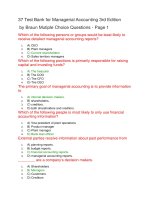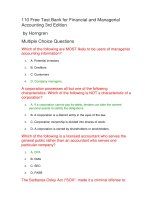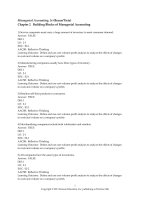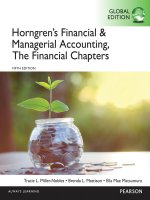Financial managerial accounting 3rd kieso ch25(planning for capital investments)
Bạn đang xem bản rút gọn của tài liệu. Xem và tải ngay bản đầy đủ của tài liệu tại đây (185.7 KB, 55 trang )
Financial & Managerial Accounting
rd
3 Edition
Weygandt Kimmel Kieso
Chapter 25
Planning for Capital Investments
Prepared by
Coby Harmon
University of California, Santa Barbara
Westmont College
Chapter Outline
Learning Objectives
LO 1
Describe capital budgeting inputs and apply the cash payback technique.
LO 2
Use the net present value method.
LO 3
Identify capital budgeting challenges and refinements.
LO 4
Use the internal rate of return method.
LO 5
Use the annual rate of return method.
Copyright ©2018 John Wiley & Son, Inc.
2
Capital Budgeting and Cash Payback
Corporate capital budget authorization process:
1.
Proposals for projects are requested from each department, plants, and authorized
personnel.
LO 1
2.
Proposals are screened by a capital budget committee.
3.
Officers determine which projects are worthy of funding.
4.
Board of directors approves capital budget.
Copyright ©2018 John Wiley & Son, Inc.
3
Cost Flow Information
For purposes of capital budgeting, estimated cash inflows and outflows are the preferred
inputs.
Why?
Ultimately, the value of all financial investments is determined by the value of cash flows
received and paid.
LO 1
Copyright ©2018 John Wiley & Son, Inc.
4
Cost Flow Information
Cash Outflows
ILLUSTRATION 25.2
Typical cash flows relating to
Initial investment
capital budgeting decisions
Repairs and maintenance
Increased operating costs
Overhaul of equipment
Cash Inflows
Proceeds from sale of old equipment
Increased cash received from customers
Reduced cash outflows related to operating costs
Salvage value of equipment
LO 1
Copyright ©2018 John Wiley & Son, Inc.
5
Cost Flow Information
Capital budgeting decisions depend on:
a. Availability of funds
b. Relationships among proposed projects
c. Company’s basic decision-making approach
d. Risk associated with a particular project
LO 1
Copyright ©2018 John Wiley & Son, Inc.
6
Illustrative Data
Stewart Shipping Company is considering an investment of $130,000 in new equipment.
Initial investment
$130,000
Estimated useful life
10 years
Estimated salvage value
-0-
Estimated annual cash flows
Cash inflows from customers
$200,000
Cash outflows for operating costs
176,000
Net annual cash flow
$ 24,000
ILLUSTRATION 25.3
Investment information for Stewart Shipping example
LO 1
Copyright ©2018 John Wiley & Son, Inc.
7
Cash Payback
Cash payback technique identifies time period required to recover cost of capital investment
from net annual cash inflow produced by investment.
Cash payback period for Stewart is …
ILLUSTRATION 25.4
Cash payback formula
Cost of Capital Investment
$130,000
LO 1
÷
÷
Net Annual Cash
Flow
$24,000
Copyright ©2018 John Wiley & Son, Inc.
=
=
Cash Payback Period
5.42 years
8
Cash Payback
Shorter payback period = More attractive investment
In case of uneven net annual cash flows, company determines cash payback period when:
Cumulative net cash flows
from investment
LO 1
=
Copyright ©2018 John Wiley & Son, Inc.
Cost of investment
9
ILLUSTRATION 25-5
Computation of cash payback period—
Cash Payback
unequal cash flows
Illustration: Chen Company proposes an investment in a new website that is estimated to
cost $300,000.
Net Annual Cash
Year
0
Investment
Flows
Cumulative Net Cash Flow
$300,000
1
$60,000
$60,000
2
90,000
150,000
3
90,000
240,000
4
120,000
360,000
5
100,000
460,000
Cash payback period = 3.5 years
LO 1
Copyright ©2018 John Wiley & Son, Inc.
10
Cash Payback
A $100,000 investment with a zero scrap value has an 8-year life. Compute the payback
period if straight-line depreciation is used and net income is determined to be $20,000.
LO 1
a.
8.00 years.
b.
3.08 years.
c.
5.00 years.
d.
13.33 years.
Copyright ©2018 John Wiley & Son, Inc.
11
DO IT! 1 Cash Payback Period
Watertown Paper Corporation is considering adding another machine for the manufacture of corrugated
cardboard. The machine would cost $900,000. It would have an estimated life of 6 years and no salvage value.
The company estimates that annual cash inflows would increase by $400,000 and that annual cash outflows
would increase by $190,000. Compute the cash payback period.
Estimated annual cash inflows
$400,000
Estimated annual cash outflows
190,000
Net annual cash flow
$210,000
Cash payback period = $900,000/$210,000 = 4.3 years
LO 1
Copyright ©2018 John Wiley & Son, Inc.
12
Net Present Value Method
Discounted cash flow technique:
a. Generally recognized as best approach
b. Considers both estimated total cash inflows and time value of money
c. Two methods:
LO 2
Net present value (NPV)
Internal rate of return (IRR)
Copyright ©2018 John Wiley & Son, Inc.
13
Net Present Value Method
a. Cash inflows are discounted to their present value and then compared with capital outlay
required by investment
b. Interest rate used in discounting is required minimum rate of return
c. Proposal is acceptable when NPV is zero or positive
d. Higher positive NPV, more attractive investment
LO 2
Copyright ©2018 John Wiley & Son, Inc.
14
Present Value of Net Cash
Flows
Net Present Value
Method
Proposal is acceptable when
Less
net present value is zero or
Capital
positive.
Investment
Less
If zero or positive:
If negative:
Net Present Value
Accept
Proposal
Reject
ILLUSTRATION 25.6
Proposal
Net present value decision criteria
LO 2
Copyright ©2018 John Wiley & Son, Inc.
15
Equal Annual Cash Flows
Illustration: Stewart Shipping Company example, the company’s net annual cash flows are $24,000. If we
assume this amount is uniform over the asset’s useful life, we can compute the present value of the net
annual cash flows.
Present Value
at 12%
Discounted factor for 10 periods
5.65022
Present value of net cash flows:
$24,000 × 5.65022
$135,605
ILLUSTRATION 25.7
Computation of present value of equal net annual cash flows
LO 2
Copyright ©2018 John Wiley & Son, Inc.
16
Equal Annual Cash Flows
ILLUSTRATION 25.8
Computation of net present value—equal net
annual cash flows
Illustration: Calculate the net present value.
12%
Present value of net cash flows
$135,605
Less: Capital investment
130,000
Net present value
$ 5,605
Proposed capital expenditure is acceptable at a required rate of return of 12% because the net
present value is positive.
LO 2
Copyright ©2018 John Wiley & Son, Inc.
17
Unequal Annual Cash Flows
Illustration: Stewart Shipping Company expects the same total net cash flows of $240,000 over the
life of the investment. Because of a declining market demand for the new product the net annual
cash flows are higher in the early years and lower in the later years.
The present value of the net annual cash flows is calculated as follows.
LO 2
Copyright ©2018 John Wiley & Son, Inc.
18
Discount Factor
Year
Assumed Net Annual Cash Flows
12%
Present Value 12%
(1)
(2)
(1) x (2)
1
$34,000
0.89286
$30,357
2
30,000
0.79719
23,916
3
27,000
0.71178
19,218
4
25,000
0.63552
15,888
5
24,000
0.56743
13,618
6
22,000
0.50663
11,146
7
21,000
0.45235
9,499
8
20,000
0.40388
8,078
9
19,000
0.36061
6,852
10
18,000
0.32197
5,795
$240,000
$144,367
ILLUSTRATION 25.8
Computation of present value—unequal annual cash flows
LO 2
Copyright ©2018 John Wiley & Son, Inc.
19
Unequal Annual Cash Flows
ILLUSTRATION 25.10
Computation of net present value—unequal
annual cash flows
Illustration: Calculate the net present value.
12%
Present value of net cash flows
$144,367
Less: Capital investment
130,000
Net present value
$ 14,367
Proposed capital expenditure is acceptable at a required rate of return of 12% because the net
present value is positive.
LO 2
Copyright ©2018 John Wiley & Son, Inc.
20
Choosing a Discount Rate
In most instances a company uses a required rate of return equal to its cost of capital — that
is, the rate that it must pay to obtain funds from creditors and stockholders.
Discount rate has two elements:
•
Cost of capital
•
Risk
Rate also know as required rate of return, hurdle rate, and cutoff rate.
LO 2
Copyright ©2018 John Wiley & Son, Inc.
21
Choosing a Discount Rate
Illustration: Stewart Shipping used a discount rate of 12%. Suppose this rate does not take into account the
risk of the project. A more appropriate rate might be 15%.
Present Values at
ILLUSTRATION 25.11
Comparison of net present value at different discount rates
Different Discount Rates
12%
Discounted factor for 10 periods
5.65022
15%
5.01877
Present value of net cash flows:
$24,000 × 5.65022
$135,605
$24,000 x 5.01877
$120,450
Less: Capital investment
Positive (negative) net present value
LO 2
Copyright ©2018 John Wiley & Son, Inc.
130,000
130,000
$ 5,605
$ (9,550)
22
Simplifying Assumptions
LO 2
•
All cash flows come at end of each year
•
All cash flows are immediately reinvested in another project that has a similar return
•
All cash flows can be predicted with certainty
Copyright ©2018 John Wiley & Son, Inc.
23
Net Present Value (NPV) Method
Compute the net present value of a $260,000 investment with a 10-year life, annual cash inflows of
$50,000 and a discount rate of 12%.
LO 2
a.
$(9,062)
b.
$22,511
c.
$9,062
d.
$(22,511)
Copyright ©2018 John Wiley & Son, Inc.
24
ILLUSTRATION 25.12
Comprehensive Example (1 of 3)
Investment information for Best Taste Foods
example
Best Taste Foods is considering investing in new equipment to produce fat-free snack foods.
Initial investment
$1,000,000
Cost of equipment overhaul in 5 years
$200,000
Salvage value of equipment in 10 years
$20,000
Cost of capital (discount rate)
15%
Estimated annual cash flows
LO 2
Cash inflows received from sales
$500,000
Cash outflows for cost of goods sold
$200,000
Maintenance costs
$30,000
Other direct operating costs
$40,000
Copyright ©2018 John Wiley & Son, Inc.
25









